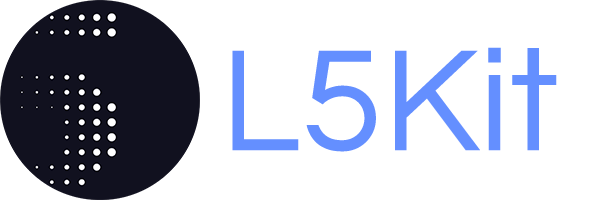Coordinate Systems in L5Kit¶
One essential feature of L5Kit is converting raw data into multi-channel images. We refer to this process as rasterisation. These raw data can come from different sources, such as:
.zarrdatasets, which include information about the AV and other agents;static aerial images;
dynamic semantic maps, which include lane topologies, crosswalks, etc..
Clearly, these different sources can have different coordinates systems, which need to be converted to a single common system before we can use them together to get our final multi-channel image. L5Kit performs this operation smoothly under the hood, but you may want to know more details about these different systems if you’re trying a more experimental workflow.
World Coordinate System¶
We refer to the coordinate system in the .zarr dataset as world. This is shared by all our zarrs in a dataset
and is a 3D metric space. The entities living in this space are the AV and the agents:
AV: samples from the AV are collected using several sensors placed in the car. The AV translation is a 3D vector (XYZ), while the orientation is expressed as a 3x3 rotation matrix (counterclockwise in a right-hand system).
Agents: samples from other agents are generated while the AV moves around. The translation is a 2D vector (XY) and the orientation is expressed via a single yaw angle (counterclockwise in radians).
The origin of the world coordinate system is located at [37°25’45.6”N, 122°09’15.7”W] in Palo Alto (California, USA).
Agent Coordinate System¶
A common feature of the BEV’s rasterisation is that the agent of interest is always aligned in the same direction. In L5Kit this direction is right (i.e. the hood of the agent of interest always points to the right side of the image).
This metric space is referred to as agent and has the following features:
The agent’s position is at (0, 0);
The agent’s yaw is 0.
If you’re using one of our high-level dataset objects (either EgoDataset or AgentDataset) to generate samples, you can
access the agent-from-world matrix using the agent_from_world key of the returned dict.
Note: This space is aligned with the input raster except for an intrinsic transformation (i.e. meters to pixels), which makes this space suitable as a target during training.
Image Coordinate System¶
Once rasterisation is complete, the final multi-channel image will be in the image space. This is a 2D space where (0,0) is located in the top-left corner.
If you’re using one of our high-level dataset objects (either EgoDataset or AgentDataset) to generate samples, you can
access the raster-from-world matrix using the raster_from_world key on the returned dict. When building this matrix, several steps are combined:
Translate world to ego by applying the negative
ego_translation;Rotate counter-clockwise by negative
ego_yawto align world such that ego faces right in the image;Scale from meters to pixels based on the value
pixel_sizeset in the configuration;Translate again such that the ego is aligned to the value
ego_centerin the configuration.
Note: we ignore the z coordinate in this transformation
With this matrix, you can transform a point from world to image space and vice versa using its inverse.
One application of this is drawing trajectories on the image:
data = dataset[0] # this comes from either EgoDataset or AgentDataset
im = dataset.rasterizer.to_rgb(data["image"].transpose(1, 2, 0)) # convert raster into rgb
# transform points from agent local coordinate to world coordinate
positions_in_world = transform_points(data["target_positions"], data["world_from_agent"])
# transform from world coordinates onto raster
positions_in_raster = transform_points(positions_in_world, data["raster_from_world"])
draw_trajectory(im, positions_in_raster, TARGET_POINTS_COLOR, yaws=data["target_yaws"])
Satellite Coordinate System¶
Satellite information is stored as an RGB image in the aerial_map folder of the dataset. Together with that we provide
a matrix to convert from the ECEF reference system to this image reference system (i.e. converting XYZ ECEF coordinates into a 2D pixel coordinates).
However, the .zarr stores information in the world reference system. As such, an additional conversion is required from world to this image reference system:
world coordinates must be converted into ECEF coordinates. This transformation matrix is currently hard-coded but will be shipped with the dataset in the future. It is dataset dependent as it encodes where the dataset world origin is located in the Earth frame;
ECEF coordinates must be converted into the aerial image reference system using the above mentioned matrix.
The SatelliteRasterizer and its derived classes combine these two matrices into a single one and directly convert
world coordinates from the .zarr into 2D pixels coordinates. In this way, you can rasterise around an agent in the .zarr (whose coordinates are in the world reference system)
Semantic Coordinate System¶
Semantic information is stored as a protobuf file. The protobuf store information as a list of elements of different types (e.g lanes, crosswalks, etc).
Each elements can have one or multiple geometric features (e.g. the left and right lane boundaries) which are described as a list of 3D points.
Each element’s features are localised in its local coordinate system:
features coordinates are expressed in centimeters deltas in an ENU reference system. This system is valid only for that feature (i.e. two features with the same coordinates values are not in the same location);
the system latitude and longitude, which localise the feature in a global reference system.
This can be used for example to move the feature into a common space (e.g. world or ECEF)
The MapAPI class has a set of functionality to convert these local spaces into a global reference system.
When you query it for a supported element (only lanes and crosswalks currently):
the geometric feature(s) is converted from deltas to absolute values;
the feature is then converted from ENU into ECEF by using its GeoFrame reference (lat, lng);
the features is finally converted from ECEF to world (this is the reason for the
world_to_ecefarg in theMapAPIconstructor).
As these operations are computationally expensive, the function results are LRUcached
Visualization Notebook¶
Our visualisation notebook is the perfect place to start if you want to know more about L5Kit dataset format and coordinate systems.
